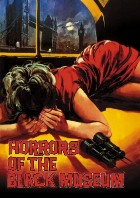
Focusing on style and mood more often than plot or nuances of characterization, the horror movie has long been decried as a formulaic product more surface sensationalism than interior reflection, more slash than substance. While these naysayers undoubtedly have a point, they often choose the worst examples by which to define the genre. The best horrific films, from supernatural thrillers that challenge the nature of reality to psychological thrillers than shadow-dance the frail lines between objective reality and subjective deviance, exhibit the ability to combine surface action with serious philosophical investigation. This is equally true for the sub-genre of the dark mystery/thriller, which focuses as much on the internal motivations of debauchery as on physical viscera. As much cranium carnival as celebration of carnality, Horrors of the Black Museum is a putrid display of surprisingly graphic, mean-spirited violence; it is also a top-notch, intelligent murder mystery, pleasing devotes of classic restrained macabre as well as fans of the more modern slasher hybrid.
Dressing the traditional mystery/thriller up in the funeral finery of the modern horror film, Horrors challenges assumptions of taste and expectation just as strongly - and with as much class - as it induces terror. From the unforgettable opening shot of a young woman adjusting a pair of binoculars at the window only to receive amateur eye surgery, to the emotionally scathing examinations of the deviant mind inherent in the performances, this fright film is both an unapologetic horror movie of raw sensationalism and a provoking emotional vivisection of human kind's paradoxical fascination with, and fear of, violence. Artfully depicted moments of lyrical, beautiful brutality share center-stage with intimately believable characterizations.
The plot, directly told with refreshing subtext, focuses on a shocking sequence of grisly murders that have left Scotland Yard completely baffled. Edmond Bancroft (Michael Gough), a horror writer (a particularly significant occupation perhaps, suggesting the interwoven relationship between art and life, violence and its appreciation?) exploits the crimes in his newspaper column during the day while he mocks the authorities for their inability to capture him. Bancroft is fascinated with grisly crimes and murder, harboring infamous devices of torture in his "Black Museum." Featuring the undeniable acting charisma and disturbing intensity of Michael Gough, the film also boasts credible, sympathetic performances by June Cunningham, Graham Curnow, Shirley Anne Field, Geoffrey Keen, and Gerald Anderson, et, all. More importantly, the story is well constructed, inviting audience involvement while the putrid plot unravels (along with Bancroft's sanity!).
Athur Crabtree (the director) and Herman Gohen (producer/writer)of this sensitive screenplay infuses dramatic moments of psychological vivisection with inspiration and verve, crafting moments of tension and pathos similar to Greek tragedy. The audience is invited to experience catharsis in the strangely sympathetic if admittedly terrible anti-hero, whose secret room of killing/torture artifacts isn't simply physical proof of his fetish but also a representation of our species' interest in preserving, studying, and enjoying the violence that we likewise resist. This may also symbolize the function of the horror genre in general, which grants audiences the ability to face morality, mortality, and the chaos of obsession in a relatively safe environment.
A specialized dark corner of the psychological horror genre, this mad ménage of psycho-sexual obsession with murder also warns against hubris, focusing on the titular main character's delight in instigating a cat-and-mouse game of wits with the very same police force he works for. While this film has courted controversy and admiration for its violence, sexual innuendo, and stylistic intensity, it is perhaps most influential for its early focus on the nature of voyeurism, suggesting in its narrative the disturbing relationship between viewer and actor, director and film, life and art.
A frightfully fiendish ménage of sensationalism and intelligence, Horrors of the Black Museum captures the atmosphere of its cinematic ancestors while effectively returning the form to its roots. The plot, a creative and thought-provoking parable of madness, greed, and internal terror, is magnified by the deadly if beautiful atmosphere. Tension is evoked by inspired direction and settings convincingly rendered despite a meager budget, focusing our attentions on the problems of perception and the process of deduction so important to the thriller.
The print offered by VCI Entertainment is in a pristine 2.35:1 widescreen presentation (16:9 anamorphic). In a transfer that borders on the miraculous considering the age of the film, the picture is generally pleasing, clear of scratches or lines. Colors are bold and enticing, with a commendable lack of softness. Sound is just as professional, with a Dolby Digital audio track crisp and free of hissing or muddled dialogue. While a French track is included, no subtitles are available.
The extras are both attractive and extensive, establishing a historical and cultural subtext for the feature film. The first audio commentary includes legendary exploitation producer Herman Cohen as he discusses the film's origins, pre-planning and production, and, of most interest, personal recollections of cast and crew. The second, more surprising commentary features the composer Gerard Schurmann and David Del Valle, a critic. "Video Tribute to Producer Herman Cohen," a 20-minute documentary/profile narrated by Didier Chatelain, investigates the late producer's life. The Hypno-Vista pre-credit sequence from the original feature ensues, which is followed by American and European theatrical trailers. A phone interview with Herman Cohen is enjoyable if brief, and the obligatory cast & crew filmographies, a still gallery, and delightful trailers complete this loving presentation. This is a respectful package honoring a provocative peon to perversity!
Review by William P Simmons
| Released by VCI |
| Region 1 - NTSC |
| Not Rated |
| Extras : |
| see main review |